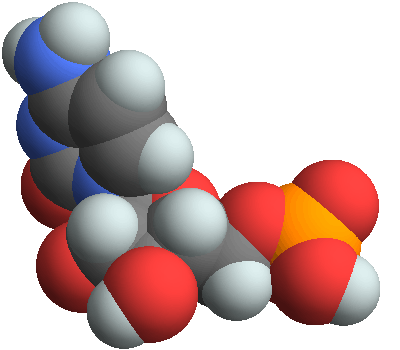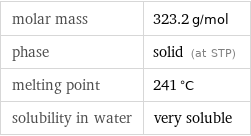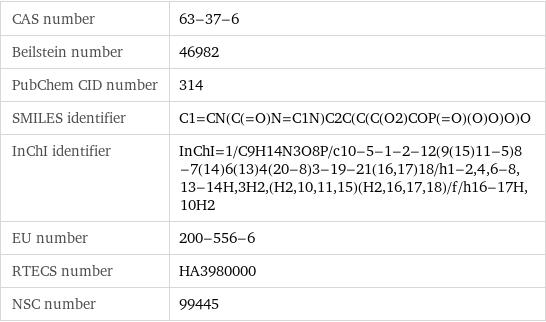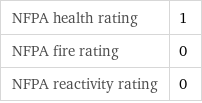Input interpretation

cytidylic acid
Chemical names and formulas
![formula | C_9H_14N_3O_8P name | cytidylic acid IUPAC name | [5-(4-amino-2-oxo-pyrimidin-1-yl)-3, 4-dihydroxy-oxolan-2-yl]methoxyphosphonic acid alternate names | 5'-cytidylic acid | cytidine 5'-monophosphate mass fractions | C (carbon) 33.4% | H (hydrogen) 4.37% | N (nitrogen) 13% | O (oxygen) 39.6% | P (phosphorus) 9.58%](../image_source/8042da838f867b9cc4a1cbba636e62c6.png)
formula | C_9H_14N_3O_8P name | cytidylic acid IUPAC name | [5-(4-amino-2-oxo-pyrimidin-1-yl)-3, 4-dihydroxy-oxolan-2-yl]methoxyphosphonic acid alternate names | 5'-cytidylic acid | cytidine 5'-monophosphate mass fractions | C (carbon) 33.4% | H (hydrogen) 4.37% | N (nitrogen) 13% | O (oxygen) 39.6% | P (phosphorus) 9.58%
Lewis structure

Draw the Lewis structure of cytidylic acid. Start by drawing the overall structure of the molecule, ignoring potential double and triple bonds: Count the total valence electrons of the carbon (n_C, val = 4), hydrogen (n_H, val = 1), nitrogen (n_N, val = 5), oxygen (n_O, val = 6), and phosphorus (n_P, val = 5) atoms: 9 n_C, val + 14 n_H, val + 3 n_N, val + 8 n_O, val + n_P, val = 118 Calculate the number of electrons needed to completely fill the valence shells for carbon (n_C, full = 8), hydrogen (n_H, full = 2), nitrogen (n_N, full = 8), oxygen (n_O, full = 8), and phosphorus (n_P, full = 8): 9 n_C, full + 14 n_H, full + 3 n_N, full + 8 n_O, full + n_P, full = 196 Subtracting these two numbers shows that 196 - 118 = 78 bonding electrons are needed. Each bond has two electrons, so in addition to the 36 bonds already present in the diagram we expect to add 3 bonds. To minimize formal charge oxygen wants 2 bonds, nitrogen wants 3 bonds, and carbon wants 4 bonds. Identify the atoms that want additional bonds and the number of electrons remaining on each atom: Add 3 bonds by pairing electrons between adjacent highlighted atoms. Additionally, atoms with large electronegativities can minimize their formal charge by forcing atoms with smaller electronegativities on period 3 or higher to expand their valence shells. The electronegativities of the atoms are 2.19 (phosphorus), 2.20 (hydrogen), 2.55 (carbon), 3.04 (nitrogen), and 3.44 (oxygen). Because the electronegativity of phosphorus is smaller than the electronegativity of oxygen, expand the valence shell of phosphorus to 5 bonds. Therefore we add a total of 4 bonds to the diagram: Answer: | |
3D structure

3D structure
Basic properties

molar mass | 323.2 g/mol phase | solid (at STP) melting point | 241 °C solubility in water | very soluble
Units

Solid properties (at STP)

vapor pressure | 3×10^-21 mmHg (at 25 °C)
Units

Chemical identifiers

CAS number | 63-37-6 Beilstein number | 46982 PubChem CID number | 314 SMILES identifier | C1=CN(C(=O)N=C1N)C2C(C(C(O2)COP(=O)(O)O)O)O InChI identifier | InChI=1/C9H14N3O8P/c10-5-1-2-12(9(15)11-5)8-7(14)6(13)4(20-8)3-19-21(16, 17)18/h1-2, 4, 6-8, 13-14H, 3H2, (H2, 10, 11, 15)(H2, 16, 17, 18)/f/h16-17H, 10H2 EU number | 200-556-6 RTECS number | HA3980000 NSC number | 99445
NFPA label

NFPA label

NFPA health rating | 1 NFPA fire rating | 0 NFPA reactivity rating | 0
Toxicity properties

RTECS classes | mutagen